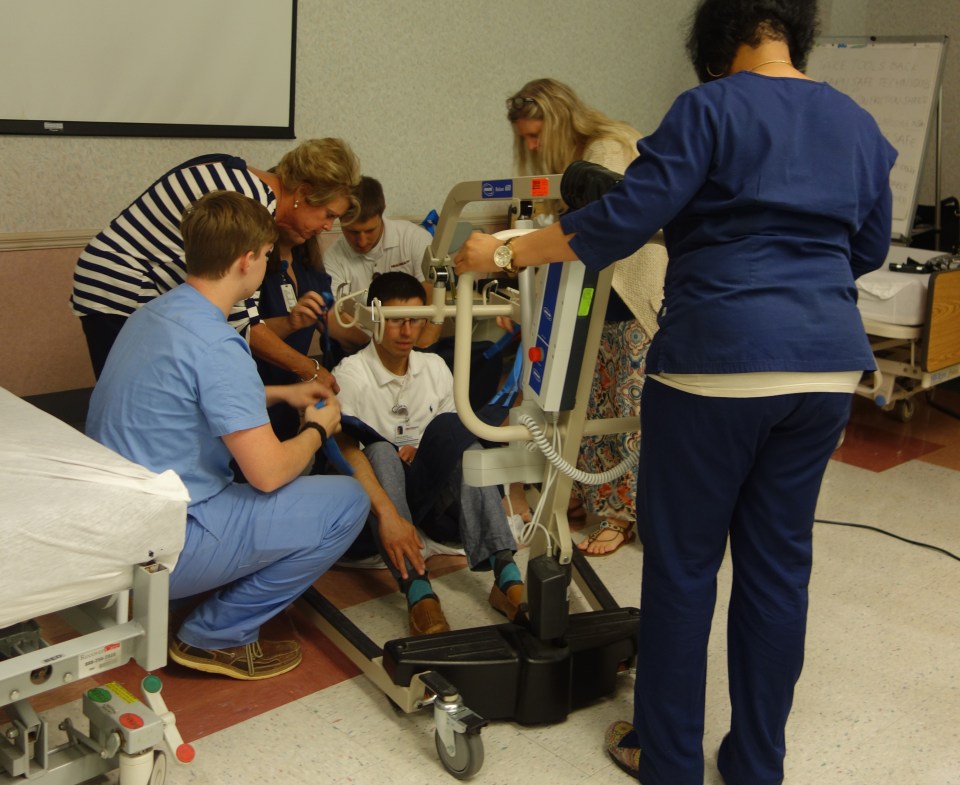When it comes to injuries in the workplace, healthcare tops the list as one of the most hazardous environments to work in, surpassing even the construction and manufacturing industries.
Injuries account for more missed work days in healthcare than illnesses, according to OSHA, and the most common are sprains and strains. Over time, many of those injuries can be career ending, so how can healthcare providers prevent these injuries from occurring? One way is by ensuring clinicians are safely moving patients.
Encompass Health created and implemented its safe mobility program, STOP—Stop, Think, Organize and Position—in 2014. The first part of the program teaches all employees basic injury prevention techniques. STOP 2 is specific to clinicians, training them in a safe patient transfer protocol in an effort to reduce employee injuries while making these transfers. It’s that program that has really helped reduce the number of employee injuries.
From 2014 to 2017, the Company’s workers’ compensation claims and costs are down for the entire program, and the single injury cause with the most improvement was injuries caused from patient mobility activities. Lynne Lee, Encompass Health’s vice president of risk management said much of that has to be attributed to the STOP 2 program.
“We have studied this trend quite extensively and because we have seen this across the Company, not just in a few hospitals or regions, we looked for common denominators in organization-wide safety programs,” she said. “After discussions with clinical leaders, we have concluded that these great numbers are due to the impact of the STOP program.”
Why it works
Acknowledging the fact that healthcare employees are at a higher risk of injuries than most and that many of those strains and sprains that prevent clinicians from performing their work often occur while transferring a patient, the Company sought to develop a standardized safe patient mobility protocol. It partnered with Medco Technology, a company that specializes in safe patient mobility solutions, to create the STOP 2 program.
It was first piloted in a handful of hospitals, and then implemented companywide in 2014.
“Encompass Health has really been fantastic in recognizing that we’re in a high-risk industry,” said Chelsee Wood, a nurse manager at Encompass Health Rehabilitation Hospital of Colorado Springs and also a STOP program trainer. “The wear and tear of weeks and months of using poor body mechanics can add up overtime, and the unpredictable movement of a patient can end a career.”
STOP 2 requires clinicians to assess the patient’s movement with a 5-second mobility screening, determining the need for additional assistance or if mobility equipment is needed to make a safe transfer.
For too long, Wood said, many clinicians assumed that the heavy lifting of patients, even at the risk of injury, was a given in healthcare. She said the STOP 2 program is helping change that mentality at Encompass Health hospitals, prompting them to use the proper equipment — such as slide sheets and lifts — for more difficult patient transfers, as well as calling for assistance before attempting to make a difficult transfer.
“This program really spoke to me in that I didn’t realize I was getting into such a dangerous profession,” Wood said. “But there are tools out there to help. You wouldn’t change an IV without gloves, so why wouldn’t you use this equipment that could help protect you from an injury?”
How do you convince employees that injuries aren’t part of the job in healthcare? The best way to change that mindset is through training–lots of it.
Training and re-train
All new Encompass Health hospital employees are required to undergo three hours of STOP 2 training as part of orientation, but training doesn’t end there.
Each hospital has at least one STOP champion. These champions undergo extensive training and are the go-to people at each hospital for anything STOP related.
Other ways in which the Company are training and retraining employees since implementing the program companywide include:
- There have been six to eight regional boot camps annually to maintain hospital trainers
- Regional STOP champions have been identified and conduct monthly calls with hospital trainers
- All trainings are led by someone who has extra training in STOP 2, and has attended one of the Company’s STOP 2 boot camps, which are designed to train the hospital level trainers
- Each region of Encompass Health has a set of regional STOP 2 trainers responsible for leading the boot camps for their region.
- Each hospital STOP champion and their teams are required to do yearly competencies on STOP 2 principles/practices
- There was a refreshed STOP curriculum for regional trainers in early 2017
- The STOP team updated and rolled out a new playbook in March 2017
Wood said the regional calls have been extremely helpful in seeing how other hospitals are tackling a problem she might be having at hers.
“Anybody can chime in and ask questions about things they may be struggling with or some of their hospital’s goals,” she said. “The more we’re talking about it and continuously providing education and supporting people and being present in tough transfer situations, the better.”
The content of this site is for informational purposes only and should not be taken as professional medical advice. Always seek the advice of your physician or other qualified healthcare provider with any questions you may have regarding any medical conditions or treatments.



